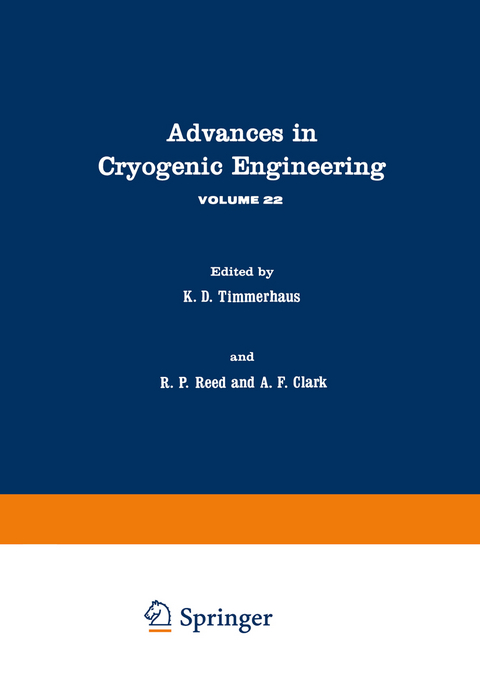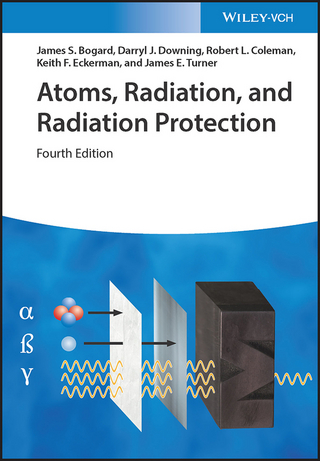
Advances in Cryogenic Engineering
Springer-Verlag New York Inc.
978-1-4613-9852-3 (ISBN)
Structural Alloys—Fracture.- A—1 A Research Program on the Properties of Structural Materials at 4 K.- A—2 Fracture Mechanics and Its Application to Cryogenic Structures.- A—3 The Fracture Toughness of Cryogenic Steels.- A—4 Fatigue Crack Growth Rates of Structural Alloys at 4 K.- A—5 Cryogenic Fracture Mechanics Properties of Several Manufacturing Process/Heat Treatment Combinations of Inconel X750.- A—6 Microstructures of Inconel X750 for Cryogenic Structural Applications.- A—7 The Fracture Toughness and Fatigue Crack Growth Rate of an Fe-Ni-Cr Superalloy at 298,76, and 4 K.- A—8 Evaluation of Inconel X750 Weldments for Cryogenic Applications.- A—9 Accident Simulation Tests on a Wet-Wall LNG Design.- A—10 Plasticity and Fracture of Ductile Structural Alloys under Plane Stress at Low Temperatures.- A—11 Crack Tip Strain Field of Strain-Hardening Materials at Low Temperature.- A—12 Mechanical Property Measurement Techniques of Structural Materials at Cryogenic Temperatures.- Structural Alloys—Physical Properties.- B—1 Magnetothermal Conductivity of Selected Pure Metals and Alloys.- B—2 Thermal and Electrical Measurements on Selected Materials for Low-Temperature Applications.- B—3 Thermal Conductivity of Selected Alloys at Low Temperatures.- B—4 Low-Temperature Thermal Conductivity and Dislocation Structures in Copper—Aluminum Alloys under High-Cycle Low-Stress Fatigue.- B—5 Measurement of Thermal Conductance.- B—6 Magnetic and Thermal Properties of Stainless Steel and Inconel at Cryogenic Temperatures.- B—7 Low-Temperature Elastic Properties of Invar.- B—8 Embrittlement Mechanisms in a Hydrogen Environment.- Composites.- C—1 Application of Fiber-Reinforced Polymers to Rotating Superconducting Machinery.- C—2 StaticTensile Properties of Boron—Aluminum and Boron—Epoxy Composites at Cryogenic Temperatures.- C—3 Low Thermal Flux Glass-Fiber Tubing for Cryogenic Service.- C—4 Optimization of Mechanical Supports for Large Superconductive Magnets.- Insulators—Thermal.- D—1 Aging Characteristics of Polyurethane Foam Insulation.- D—2 Cellular Glass Insulation for Load-Bearing Application in the Storage of Cryogenic Fluids.- D—3 Thermal Conductivity of Microsphere Cryogenic Insulation.- D—4 Apparent Thermal Conductivity of Uncoated Microsphere Cryogenic Insulation.- D—5 Thermal Performance of Multilayer Insulation Applied to Small Cryogenic Tankage.- Insulators—Electrical.- E—1 Low-Temperature Properties of Resins and Their Correlations.- E—2 Evaluation of Pre-Impregnated Resin-Glass Systems for Insulating Superconducting Magnets.- E—3 Dielectric Design Considerations for a Flexible Superconducting Power Transmission Cable.- E—4 Surface Flashover Voltage of Spacers in Vacuum at Cryogenic Temperatures.- E—5 Dimensional Behavior of Thin-Film Dielectric Polymers in the Temperature Range 4.2 to 300 K.- Superconductors.- F—1 Superconducting Materials for Large Scale Applications.- F—2 Effect of Metallurgical Treatments on AC Losses of Nb3Sn Produced by Solid State Diffusion.- F—3 Critical Current and AC Loss of Coevaporated Nb3Sn Superconductors.- F—4 Nb3Sn for Superconducting RF Cavities.- F—5 Chemical Vapor Deposition of Nb3Ge.- Superconductors—Multifilamentary.- G—1 Improvements in Critical Current Densities of Nb3Sn by Solid Solution Additions of Sn in Nb.- G—2 Performance Data of a Multifilamentary Nb3Sn Conductor and Magnet.- G—3 Test Results of a 27-Cm Bore Multifilamentary Nb3Sn Solenoid.- G—4 Superconducting Wire Test at Fermilab.-G—5 Superconducting Wires for a Pulsed Magnet.- G—6 Survey Results of Multifilamentary Nb—Ti Users.- G—7 Single-Phase Helium as Coolant for Superconducting Magnets.- G—8 Critical Rate of Magnetic Field Variation for Composite Superconductor.- G—9 Stability of Composite Superconductors under AC Conditions.- Transient Losses in Superconductors.- H—1 Technique for Measuring AC Losses in Thin-Film Superconductors.- H—2 Field Orientation Dependence of Losses in Rectangular Multifilamentary Superconductors.- H—3 Hysteresis Loss in a Multifilament Superconductor.- H—4 Design of Helically-Wound Superconducting AC Power Transmission Cables.- H—5 Interaction between Two Parallel Superconducting Wires Carrying Alternating Current.- Stress Effects in Conductor Materials.- I—1 Effect of Stress on the Critical Current of NbTi Multifilamentary Composite Wire.- I—2 Mechanical Properties of Superconducting Nb-Ti Composites.- I—3 Low Temperature Tensile Behavior of Copper-Stabilized Niobium-Titanium Superconducting Wire.- I—4 Electrical and Mechanical Properties of Dilute Aluminum—Gold Alloys at 300,77, and 4.2 K.- I—5 Effect of Cyclic Strain on Electrical Resistivity of Copper at 4.2 K.- I—6 Low Temperature Resistance of Cyclically Strained Aluminum.- I—7 Stress Analysis of Nonhomogeneous Superconducting Solenoids.- I—8 Study of Cooldown Stresses in the Cryogenic Envelope of a Superconducting Cable.- Special Materials.- J—1 Aboveground Concrete Secondary Containment for LNG.- J—2 Thin Windows for Gaseous and Liquid Targets: An Optimization Procedure.- J—3 A Promising New Cryogenic Seal Candidate.- Indexes.- Author Index.- Material Index.
| Erscheint lt. Verlag | 12.10.2012 |
|---|---|
| Reihe/Serie | Advances in Cryogenic Engineering ; 22 |
| Zusatzinfo | XI, 559 p. |
| Verlagsort | New York, NY |
| Sprache | englisch |
| Maße | 178 x 254 mm |
| Themenwelt | Schulbuch / Wörterbuch |
| Geisteswissenschaften | |
| Naturwissenschaften ► Physik / Astronomie ► Angewandte Physik | |
| Sozialwissenschaften | |
| Technik ► Maschinenbau | |
| ISBN-10 | 1-4613-9852-5 / 1461398525 |
| ISBN-13 | 978-1-4613-9852-3 / 9781461398523 |
| Zustand | Neuware |
| Haben Sie eine Frage zum Produkt? |
aus dem Bereich


